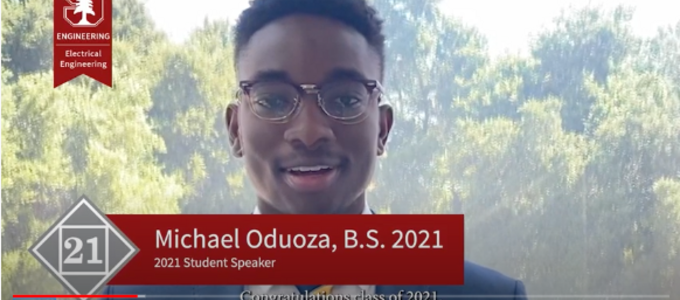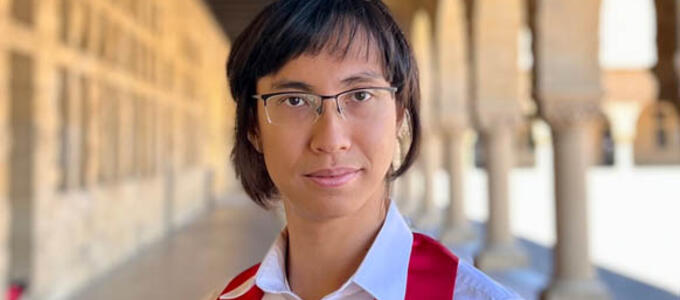
Michael Oduoza, BS'21

Kao Kitichotkul, BS'22
2021 Commencement Speech presented by Michael Oduoza, BS
Congratulations class of 2021.
Four years later, we’ve finally made it to this point.
My analogy in describing Electrical Engineering is a tree with leaves and branches. So keep this analogy in mind, because I’m going to refer back to it several times throughout this speech.
While generating ideas for this speech, I traveled back in time to freshman year, to reminisce why I chose EE. My path to EE was actually far from straightforward.
In high-school, I loved Math, Physics, and Chemistry because they explained how the complexity of our world in great detail. And coming into college, I was eager to deepen my understanding of the physical workings of the world, and for the first time, apply these fundamental principles to create useful devices and systems.
But as a freshman, I hadn’t consolidated my interests yet. I wasn’t even close. Because of this, choosing a major was very difficult for me.
I was considering several different majors, and a lot of people were actually discouraging me from pursuing EE, telling me that it’s a “dead field”, since the whole world is “software-based” now. And to make things even worse, my understanding of EE [Electrical Engineering], at that time, was unfortunately very basic.
This is where the tree analogy kicks in. Rather than viewing EE as a tree, which is what I now believe it is, my understanding of electrical engineering was more like a leaf. A leaf has only a single stem, and that stem leads to nowhere else but the leaf itself. That’s how my understanding of EE was – very one dimensional.
What do Electrical Engineers do? Well…they make sure our electricity works… But it’s really a lot more than that.
Little did I know that Electrical Engineering is not just a leaf, but this complex tree, linking several different disciplines and several different ways of thinking together. As I began to take double-E classes, I discovered that Electrical Engineers solve problems and adopt methods of thinking that I would never have even imagined.
Quantum mechanics, digital systems, computer architecture… I would never even have known Electrical Engineers thought about this kind of stuff.
It really seemed like one could go into EE and solve almost any technological problem, and this was one of the key things that really drew me into EE.
One important class I took was Professor Philip Wong’s intro-seminar: “What is Nanotechnology?” In that class, we learned about the transistor, one of the most important devices in electronics. Now, the transistor is probably the clearest example of this multidisciplinary, cross-cutting nature of EE that I’m talking about. I was amazed to see the collective effort that is required from so many different disciplines to design the transistor and develop the set of principles for how to get the best performance out of it.
From the device fabrication side of things, to device design, to circuit design, to computer architecture, all the way up to software... it’s all connected together.
And EE is the common denominator.
Now, getting back to the tree analogy. If you think about the structure of a tree, you start from the trunk of the tree, which then leads up to the crown of the tree, and then the tree breaks off into several branches, sub-branches, and, eventually, leaves.
EE is like the trunk of that tree, and all the different branches, sub-branches, and leaves, are all the disciplines that Electrical Engineers are in involved in and all the types of problems that we can solve.
EE is one of the most truly cross-cutting fields out there. This cross-cutting multidisciplinary nature of EE opens doors to so many interesting innovations and ideas that wouldn’t otherwise be possible.
Another important thing about the trunk of a tree is that it cannot be removed, or else the rest of the tree, including all the branches and leaves will fall down. The trunk is the common node that holds the entire tree together.
Similarly, as Electrical Engineers, we should stay rest-assured, knowing that the inherent cross-cutting nature of our field implies that we will always have a major role to play in technology development for the foreseeable future.
I’m also going to use a tree as an analogy for some of the trends in the electronics industry.
For the better part of the last few decades, technology development in EE has been akin to climbing up the trunk of a tree – in many cases, there was only one clear path to take, and everyone knew what kinds of rules to follow - rules like shrink the transistor, lowering the power supply voltage, increasing the clock frequency, doubling the data rate, and so on.
However, due to various physical and practical limits, simple rules like these just aren’t going to cut it anymore. From the outside, it might seem like this industry is in deep trouble, but it’s quite the opposite really. For us, this is actually perfect. This is literally the best time to be graduating from college as an EE.
There are so many challenging problems in areas such as device fabrication, wireless communications, digital systems, AI, alternative energy, that require novel and clever approaches to the way we do things.
Having traveled up the trunk of the tree for so long, the electronics industry is now approaching the crown of the tree, where the path forward is no longer so straight.
There are several possible paths and branches that can be taken in industry, and some of them will be correct, but some of them will also be wrong. And there lies the excitement in being fresh EE's, we will define the new paths, rather than simply continue to climb up the trunk of the tree.
So, remember the message – EE is like a tree. The tree describes the cross-cutting multidisciplinary nature of EE, that allows us to branch into almost any field and solve almost any technological problem. And the tree conveys the idea that there is no longer just one path forward for technological advancement.
There are several possible paths and branches that can be taken, and luckily, we’re the ones that get to define them.
2022 Commencement Speech delivered by Kao Kitichotkul, BS'22
Good afternoon faculty, staff, friends, family, and fellow graduates. It is an honor to be speaking here today. My EE journey at Stanford has been fantastic, and I am sure it has been the same for you all, fellow graduates, as well.
Electrical engineering is a very broad discipline -- from circuits, physical devices, hardware, and computer architecture to signal processing, communication, and mathematical optimization. In fact, this diversity is what drew me into EE in the first place.
I want to tell you a little bit about why I ended up in EE. Coming to Stanford, I was broadly interested in physics, CS, and science in general. Then, Pinpin, my cousin who was an EE PhD student here, told me that many of the physics and CS classes could be counted toward the EE degree. So I thought, “well since I will probably be taking physics and CS classes, I might as well check out EE.” I ended up taking many more EE classes than CS or physics. It was like a wondrous, exciting rabbit hole, and now I am in front of you all, giving this speech as an EE graduate.
I think that the breadth of topics in EE is quite interesting. It reflects that all these different areas of knowledge are necessary to build many electronic devices. For example, to build a camera, you need a lens, image sensors, an image processing pipeline, and a processor. The knowledge required to build these pieces already covers more than half of the topics in EE. The diversity of EE tells us that we must work together to build something. It is unlikely that one person could build a device on their own.
While writing this speech, it was brought to my attention that the idea of diversity in electrical engineering is a simple, yet powerful allegory; we must work together to build something.
For example, my specialization is signal processing. To build a camera, I can handle the image processing pipeline, but I need others to fabricate chips and sensors. The synergy required to make a camera, is like the synergy required to build a successful team. Or department. Or university. Or company.
I am grateful for the many opportunities to exchange ideas and collaborate with people from a variety of backgrounds while I’ve been part of Stanford EE. Learning from my friends -- many of whom are here today -- is an experience that will contribute to my success as I continue on with my education and career.
I would like to thank all faculty and staff members for your knowledge, mentorship, advice, and research opportunities. Thank you, friends, for exchanging cool ideas and making my time at Stanford fun. I know we will continue to tinker and build stuff.
I look forward to seeing what you all build! And as long as we work together to build something, we make the world a better place.
Thank you.